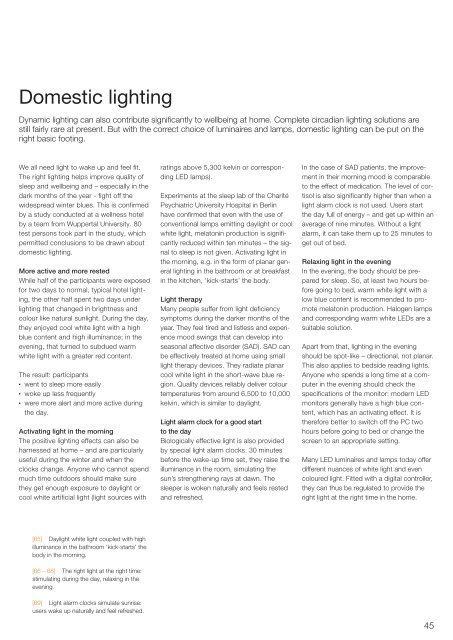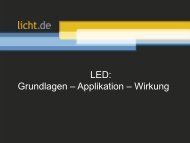licht.wissen 19 No. "Impact of Light on Human Beings"
Light synchronises our “internal clock”. Lighting that copies daylight has more than just a visual impact; it supports bodily functions 24 hours a day. Booklet 19 is intended for all those who want to delve into the topic of Impact of Light on Human Beings. The 56 pages helps to get an overview of what melanopic light can effect. Free Download at www.licht.de/en
Light synchronises our “internal clock”. Lighting that copies daylight has more than just a visual impact; it supports bodily functions 24 hours a day. Booklet 19 is intended for all those who want to delve into the topic of Impact of Light on Human Beings. The 56 pages helps to get an overview of what melanopic light can effect. Free Download at www.licht.de/en
Create successful ePaper yourself
Turn your PDF publications into a flip-book with our unique Google optimized e-Paper software.
Domestic lighting<br />
Dynamic lighting can also c<strong>on</strong>tribute significantly to wellbeing at home. Complete circadian lighting soluti<strong>on</strong>s are<br />
still fairly rare at present. But with the correct choice <str<strong>on</strong>g>of</str<strong>on</strong>g> luminaires and lamps, domestic lighting can be put <strong>on</strong> the<br />
right basic footing.<br />
We all need light to wake up and feel fit.<br />
The right lighting helps improve quality <str<strong>on</strong>g>of</str<strong>on</strong>g><br />
sleep and wellbeing and – especially in the<br />
dark m<strong>on</strong>ths <str<strong>on</strong>g>of</str<strong>on</strong>g> the year - fight <str<strong>on</strong>g>of</str<strong>on</strong>g>f the<br />
widespread winter blues. This is c<strong>on</strong>firmed<br />
by a study c<strong>on</strong>ducted at a wellness hotel<br />
by a team from Wuppertal University. 80<br />
test pers<strong>on</strong>s took part in the study, which<br />
permitted c<strong>on</strong>clusi<strong>on</strong>s to be drawn about<br />
domestic lighting.<br />
More active and more rested<br />
While half <str<strong>on</strong>g>of</str<strong>on</strong>g> the participants were exposed<br />
for two days to normal, typical hotel lighting,<br />
the other half spent two days under<br />
lighting that changed in brightness and<br />
colour like natural sunlight. During the day,<br />
they enjoyed cool white light with a high<br />
blue c<strong>on</strong>tent and high illuminance; in the<br />
evening, that turned to subdued warm<br />
white light with a greater red c<strong>on</strong>tent.<br />
The result: participants<br />
<br />
went to sleep more easily<br />
<br />
woke up less frequently<br />
<br />
were more alert and more active during<br />
the day.<br />
Activating light in the morning<br />
The positive lighting effects can also be<br />
harnessed at home – and are particularly<br />
useful during the winter and when the<br />
clocks change. Any<strong>on</strong>e who cannot spend<br />
much time outdoors should make sure<br />
they get enough exposure to daylight or<br />
cool white artificial light (light sources with<br />
ratings above 5,300 kelvin or corresp<strong>on</strong>ding<br />
LED lamps).<br />
Experiments at the sleep lab <str<strong>on</strong>g>of</str<strong>on</strong>g> the Charité<br />
Psychiatric University Hospital in Berlin<br />
have c<strong>on</strong>firmed that even with the use <str<strong>on</strong>g>of</str<strong>on</strong>g><br />
c<strong>on</strong>venti<strong>on</strong>al lamps emitting daylight or cool<br />
white light, melat<strong>on</strong>in producti<strong>on</strong> is significantly<br />
reduced within ten minutes – the signal<br />
to sleep is not given. Activating light in<br />
the morning, e.g. in the form <str<strong>on</strong>g>of</str<strong>on</strong>g> planar general<br />
lighting in the bathroom or at breakfast<br />
in the kitchen, ‘kick-starts’ the body.<br />
<str<strong>on</strong>g>Light</str<strong>on</strong>g> therapy<br />
Many people suffer from light deficiency<br />
symptoms during the darker m<strong>on</strong>ths <str<strong>on</strong>g>of</str<strong>on</strong>g> the<br />
year. They feel tired and listless and experience<br />
mood swings that can develop into<br />
seas<strong>on</strong>al affective disorder (SAD). SAD can<br />
be effectively treated at home using small<br />
light therapy devices. They radiate planar<br />
cool white light in the short-wave blue regi<strong>on</strong>.<br />
Quality devices reliably deliver colour<br />
temperatures from around 6,500 to 10,000<br />
kelvin, which is similar to daylight.<br />
<str<strong>on</strong>g>Light</str<strong>on</strong>g> alarm clock for a good start<br />
to the day<br />
Biologically effective light is also provided<br />
by special light alarm clocks. 30 minutes<br />
before the wake-up time set, they raise the<br />
illuminance in the room, simulating the<br />
sun’s strengthening rays at dawn. The<br />
sleeper is woken naturally and feels rested<br />
and refreshed.<br />
In the case <str<strong>on</strong>g>of</str<strong>on</strong>g> SAD patients, the improvement<br />
in their morning mood is comparable<br />
to the effect <str<strong>on</strong>g>of</str<strong>on</strong>g> medicati<strong>on</strong>. The level <str<strong>on</strong>g>of</str<strong>on</strong>g> cortisol<br />
is also significantly higher than when a<br />
light alarm clock is not used. Users start<br />
the day full <str<strong>on</strong>g>of</str<strong>on</strong>g> energy – and get up within an<br />
average <str<strong>on</strong>g>of</str<strong>on</strong>g> nine minutes. Without a light<br />
alarm, it can take them up to 25 minutes to<br />
get out <str<strong>on</strong>g>of</str<strong>on</strong>g> bed.<br />
Relaxing light in the evening<br />
In the evening, the body should be prepared<br />
for sleep. So, at least two hours before<br />
going to bed, warm white light with a<br />
low blue c<strong>on</strong>tent is recommended to promote<br />
melat<strong>on</strong>in producti<strong>on</strong>. Halogen lamps<br />
and corresp<strong>on</strong>ding warm white LEDs are a<br />
suitable soluti<strong>on</strong>.<br />
Apart from that, lighting in the evening<br />
should be spot-like – directi<strong>on</strong>al, not planar.<br />
This also applies to bedside reading lights.<br />
Any<strong>on</strong>e who spends a l<strong>on</strong>g time at a computer<br />
in the evening should check the<br />
specificati<strong>on</strong>s <str<strong>on</strong>g>of</str<strong>on</strong>g> the m<strong>on</strong>itor: modern LED<br />
m<strong>on</strong>itors generally have a high blue c<strong>on</strong>tent,<br />
which has an activating effect. It is<br />
therefore better to switch <str<strong>on</strong>g>of</str<strong>on</strong>g>f the PC two<br />
hours before going to bed or change the<br />
screen to an appropriate setting.<br />
Many LED luminaires and lamps today <str<strong>on</strong>g>of</str<strong>on</strong>g>fer<br />
different nuances <str<strong>on</strong>g>of</str<strong>on</strong>g> white light and even<br />
coloured light. Fitted with a digital c<strong>on</strong>troller,<br />
they can thus be regulated to provide the<br />
right light at the right time in the home.<br />
[65] Daylight white light coupled with high<br />
illuminance in the bathroom ‘kick-starts’ the<br />
body in the morning.<br />
[66 – 68] The right light at the right time:<br />
stimulating during the day, relaxing in the<br />
evening.<br />
[69] <str<strong>on</strong>g>Light</str<strong>on</strong>g> alarm clocks simulate sunrise:<br />
users wake up naturally and feel refreshed.<br />
45

















